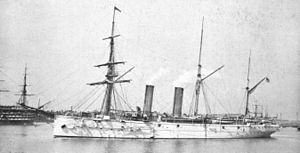The Iris class consisted of two ships, HMS Iris and HMS Mercury, built for the Royal Navy in the 1870s. They were the first British all-steel warships.

| |
| Class overview | |
|---|---|
| Name | Iris class |
| Builders | Pembroke Dockyard, Wales |
| Operators | |
| Succeeded by | Leander class |
| Built | 1875–1879 |
| In commission | 1877–1914 |
| Completed | 2 |
| Scrapped | 2 |
| General characteristics (as built) | |
| Type | Despatch ship (later protected cruiser) |
| Displacement | 3,730 long tons (3,790 t) |
| Length | 315 ft (96 m) or 331 ft 6 in (101 m) |
| Beam | 46 ft (14 m) |
| Draught | 20 ft 6 in (6.2 m) |
| Installed power | 12 boilers; 6,000 ihp (4,500 kW) |
| Propulsion | 2 × shafts; 2 × compound-expansion steam engines |
| Sail plan | Barque-rigged |
| Speed | 17 knots (31 km/h; 20 mph) |
| Range | 4,400–4,950 nmi (8,150–9,170 km; 5,060–5,700 mi) at 10 knots (19 km/h; 12 mph) |
| Complement | 275 |
| Armament | 10 × 64 pdr rifled muzzle-loading (RML) guns |
Design and description
editThe Iris-class ships were designed as dispatch vessels by William White under the direction of Nathaniel Barnaby, Director of Naval Construction, and were later redesignated as second-class protected cruisers. The only visible difference between the sister ships was that Iris had a clipper bow and was longer than Mercury with her straight stem. Iris was 331 feet 6 inches (101 m) long overall while Mercury was 315 feet (96 m) long. The sisters had a beam of 46 feet (14 m), and a draught of 20 feet 6 inches (6.2 m). They displaced 3,730 long tons (3,790 t) at normal load[1] and were the first British warships with an all-steel hull.[2] Their crew consisted of 275 officers and ratings.[1] The ships were not armoured but extensive internal subdivision gave them some protection against flooding, as did the 150-foot-long (45.7 m) double bottom under the propulsion machinery compartments.[3]
The Iris class was powered by a pair of horizontal four-cylinder Maudslay, Sons and Field compound-expansion steam engines that were configured with a pair of high-pressure cylinders with a bore of 41 inches (100 cm) and a pair of low-pressure cylinders 75 inches (190 cm) in diameter. All cylinders had a 36-inch (91 cm) stroke. Each engine drove one propeller shaft using steam from eight oval and four cylindrical boilers with a working pressure of 65 psi (448 kPa; 5 kgf/cm2).[1] The engines were designed to produce a total of 6,000 indicated horsepower (4,500 kW) for a speed of 17 knots (31 km/h; 20 mph), which was handily exceeded by the sisters. Iris initially reached a maximum speed of 16.6 knots (30.7 km/h; 19.1 mph) from 7,086 ihp (5,284 kW) during her sea trials, but after new propellers were fitted, achieved 17.89 knots (33.13 km/h; 20.59 mph) from 7,330 ihp (5,470 kW). Mercury became the fastest warship in the world when she made 18.57 knots (34.39 km/h; 21.37 mph) from 7,735 ihp (5,768 kW).[3] The ships carried a maximum of 780 long tons (793 t) of coal, enough to steam 4,400–4,950 nautical miles (8,150–9,170 km; 5,060–5,700 mi) at 10 knots (19 km/h; 12 mph). They were initially fitted with a barque sailing rig, but this was removed after a few years.[1]
The Iris-class ships were originally armed with ten 64-pounder (6.3-inch (160 mm)) rifled muzzle-loading (RML) guns, eight on the main deck and the remaining pair on the upper deck on pivot mounts to serve as chase guns fore and aft.[1]
Ships
edit| Name | Builder[3] | Laid down[3] | Launched[3] | Completed[3] | Fate[1] |
|---|---|---|---|---|---|
| Iris | Pembroke Dockyard | 10 November 1875 | 12 April 1877 | April 1879 | Sold for scrap, 11 July 1905 |
| Mercury | 16 March 1876 | 17 April 1878 | September 1879 | Sold for scrap, 9 July 1919 |
Construction and career
editIris was launched in 1877 and sold in 1905 while Mercury, launched a year later, was hulked at Chatham in 1914 and sold for scrap in 1919.[1]
Citations
editBibliography
edit- Gardiner, Robert, ed. (1992). Steam, Steel and Shellfire: The Steam Warship 1815–1905. Conway's History of the Ship. London: Conway Maritime Press. ISBN 1-55750-774-0.
- Lyon, David & Winfield, Rif (2004). The Sail & Steam Navy List: All the Ships of the Royal Navy 1815–1889. London: Chatham Publishing. ISBN 1-86176-032-9.
- Roberts, John (1979). "Great Britain". In Gardiner, Robert (ed.). Conway's All the World's Fighting Ships 1860–1905. Greenwich: Conway Maritime Press. ISBN 0-8317-0302-4.